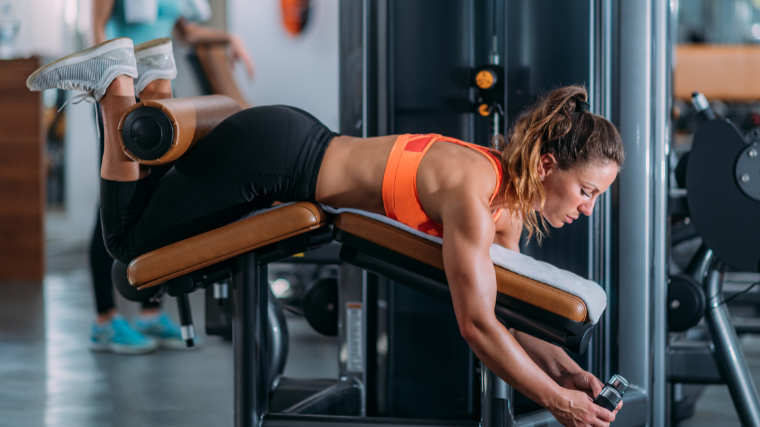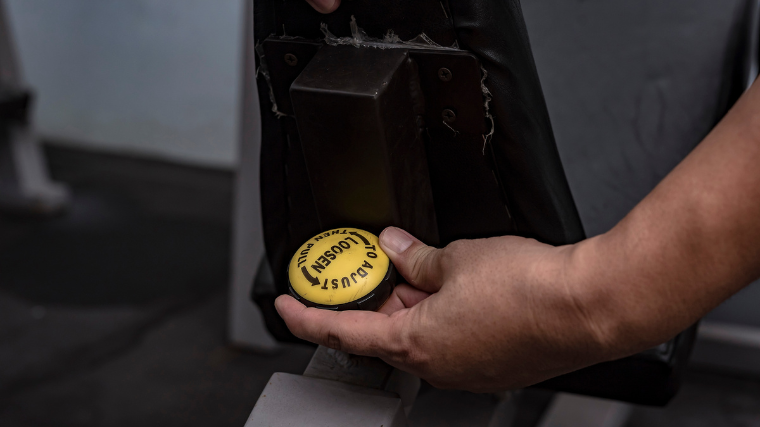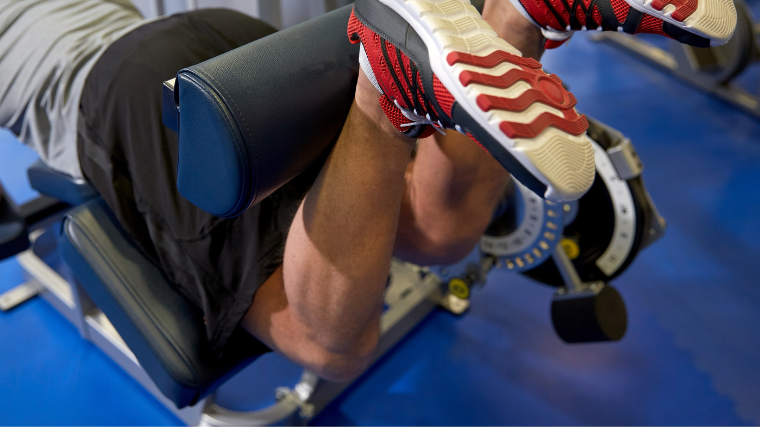Free weights generally reign supreme when it comes to the big lower body moves like the squat and deadlift. Don’t be so quick to dismiss machines, though. When you need to target specific muscle groups without taxing your whole body, machines can work wonders.

The leg curl helps you focus on your hamstrings while avoiding added stress to your lower back. This exercise will challenge your hammies and help improve your deadlift, squats, and whatever other work you want to put your legs into. Even without a leg curl machine, this guide will take you through leg curl variations and alternatives to promote all the hamstring growth you need.
How to Do the Leg Curl
The leg curl is fairly straightforward in that you’ll be using a machine to guide your movement path. That said, it can be tough being that newbie staring down the machine for minutes on end trying to figure out how to use it properly. Here’s how to go about it.
Step 1 — Set Up

Adjust the seat so that the thigh pad will be snug just above your knees, but not too tightly, sandwiching your legs between it and the seat. Pull the seat back as much as you need to in order to accommodate your stomach. Adjust the ankle pad so that when you’re sitting down, it falls comfortably under your legs just above your shoes.
Step 2 — Bend Your Knees

Once you’re set up properly, grasp the handles on either side of you. Squeeze your hands and ground your hips down into the seat. On an exhale, contract your hamstrings to bend your knees and curl your feet underneath you.
Step 3 — Slowly Extend Your Legs

After you’ve fully contracted your hamstrings, slowly let your legs extend. Control the speed of the ascent. Avoid letting the weights clang against each other at the top of the rep. Just before they make contact, begin your next rep.
Leg Curl Sets and Reps
Leg curls aren’t going to help your hamstrings pop without some significant effort. So just because you’re not going to max out with this accessory move doesn’t mean you won’t be putting some significant strength into you.
- For Muscle Mass: Perform 3-4 sets of 12-15 reps with a slow eccentric.
- For Strength: Do 2-3 sets of 8-10 reps.
- For Endurance: Perform 2-4 sets of 15-20 reps with lower weight but slow eccentrics.
When you’re primarily looking to beef up your lower body strength, make sure you’re training with enough weight to keep challenging yourself. Use a weight that will have you approaching failure near the end of each set.
Common Leg Curl Mistakes
Most machine exercises are fairly simple to execute — they’re designed that way. With stable movement pathways and simple ways to adjust the load, it’s often all laid out for you. But, you’ve got to adjust the machine — and your body — first. This can lead to some mistakes.
Incorrect Seat Position
Before you can even think about the exercise, you’ve got to adjust the machine to best suit your own body. If your thighs are thicker, you may need to adjust the seat a little lower so that there’s not too much pressure on your upper thighs from where the thigh padding and edge of the seat sandwich your legs.
For folks with larger bellies, you might want to adjust the seat back farther so that you have room to perform the exercise with a full range of motion while sitting comfortably. In either case, you’ll want to make sure that the padding above your thighs is snug but not too tight over your legs. It should be just above your knees.
Incorrect Ankle Pad Position
There will also be an ankle pad at the bottom of your legs for you to adjust, which can require a little bit of experimentation. Pull the available pin on the machine next to the pad near where your feet will be. Adjust the position so that when you sit down and loop your legs into the machine, the ankle pad will be on the underside of your legs, just above your shoes.

Adjusting the pad too high will put a lot of unnecessary pressure on your calves. It will also reduce the effective range of motion of the exercise, causing you to do a lot less work to build your hamstring muscles. Since you want to maximize your muscle recruitment here, keep the pad well below the belly of your calves.
Pushing With Your Calves
Especially if you’re new to the exercise, your calves might temporarily cramp, especially during either heavy or higher rep sets. With heavy loads, you might unconsciously recruit your calves to try and assist. If your calves aren’t ready to handle that kind of weight, they might cramp up. Try lowering the weight until your calves can come along for the ride.
[Read More: Best Calf Exercises]
With higher rep sets, your foot position might be causing your calves to cramp. Try pointing your toes instead of keeping your feet out as though you were standing regularly. In this position, you’ll be more likely to recruit force from your hamstrings and spare your calves some tension.
Leg Curl Variations
Who says you can’t do leg curls without a leg curl machine? Try these leg curl variations if your gym doesn’t have the right equipment — or if someone’s using it and has forgotten how to share.
Lying Leg Curl
If your gym doesn’t have a seated leg curl machine, see if it has a lying leg curl machine. As the name suggests, lying leg curls — sometimes also called prone leg curls — are leg curls performed lying down.
This is a very effective variation that will help you build both strength and muscle. But if your aim is hamstring hypertrophy, you might want to use a seated leg curl machine. Some research suggests that seated leg curls are better than lying leg curls at building hamstring muscle. (1)
Banded Leg Curl
The banded leg curl is a fairly direct corollary to the lying leg curl. You’ll be in the same position — lying down on your stomach — just on the floor instead of on a machine’s bench. Secure a resistance band to an anchor point behind you and loop it stably around your ankles.
The band will provide accommodating resistance such that your hamstrings will be under a high degree of tension throughout the entire range of motion. This can help increase your muscle-building potential.
Stability Ball Leg Curl
Performing a leg curl with a stability ball will have you lying on your back with the ball under your ankles. You’ll need a bunch of balance in your reserve here — you want to avoid slipping off the side of the ball.
Since you’re not using a machine, the stability ball leg curl will force you to engage your core in a much more active way. You’ll need to use a lot more core and glute strength to pull this off without tipping over.
Leg Curl Alternatives
Strength athletes and bodybuilders alike are often on the hunt for more ways to improve their hamstring size and strength. These leg curl alternatives will do the trick.
Hamstring Slides
All you need for this one is a pair of sliders and a smooth surface. You’ll lie on your back and place your heels on the sliders.
Instead of yanking your heels toward your glutes with each rep, actively grind your heels down into the ground while you bring them closer to your body. This will help you keep your hamstrings highly activated, as well as make sure you’re not just using momentum to keep moving.
Glute Bridge Walkout
For this leg curl alternative, you’ll be performing a glute bridge and combining it with a walkout. Essentially, you’ll be doing a hamstring slide — except without sliders.
You’ll be going through the same basic motion as with the slides, except in a more staccato fashion. Performing your walkouts slowly and with your core actively engaged. Keep your glutes squeezed to avoid accidentally activating your lower back.
[Read More: Best Glutes Workouts]
Glute-Ham Raise
Often performed on a glute-ham developer (a GHD), the glute-ham raise is a classic staple of CrossFit WODs (workouts of the day). Whether you’re touring your local box or tuning into the CrossFit Games, the glute-ham raise is a mainstay of glute and hamstring hypertrophy.
This is a much more advanced hamstring curl variation, as you’ll be involving your entire body. Your glutes and lower back will help out tremendously — so if you’re looking for a hamstring isolation exercise, this might not be the one for you.
Muscles Worked by the Leg Curl
The leg curl is a pretty solid isolation exercise. Unlike most leg day staples, you’re not going to be involving your whole body here. Instead, you’ll be focused on isolating those hammies.
Hamstrings
This exercise helps you train to your hamstrings to get bigger, stronger, and better at doing what they’re supposed to do — bend your legs. They also help you extend your legs, so taking it easy on the eccentric will help you keep this exercise nice and well-rounded.
Benefits of the Leg Curl
The leg curl may not get a fair shake from strength athletes who prefer multi-joint movements like the squat and deadlift. But if your favorite moves involve a barbell and a whole lot of weight plates, you might want to reconsider adding the leg curl to the mix. Here’s why.
Stronger Deadlift
The hamstrings are a vital component of every strong, powerful deadlift. But because many lifters neglect direct hamstring training, their hamstrings may become the weakest link in their deadlift pretty quickly.

If you’ve found that your deadlift training has stalled and you can’t quite break through that plateau, weak hamstrings might be to blame. In that case, leg curls can help get your hamstrings back up to par, thereby making your deadlifts that much stronger.
[Read More: Best Leg Exercises]
Reduced Lower Back Stress
All that deadlifting and squatting isn’t terribly easy on your lower back. Yes, these moves also make your low back plenty strong — but these big moves also put a lot of strain and compressed load onto your spine.
[Read More: Best Lower Back Exercises for Strength and Reduced Pain]
By performing seated leg curls, you’ll be eliminating all that pressure on your lower back while still training your hamstrings. This means you can get stronger legs while letting your back recover from those heavy sets of deadlifts.
Bigger Hamstrings
If you’re a physique athlete, you probably covet tear-drop quads accompanied by a thick and well-muscled set of hamstrings. Adding leg curls into your routine allows you to increase your hamstring volume with high-quality movements that won’t tax the rest of your body. This can help you build bigger hamstrings with a lower energy cost.
Who Should Do the Leg Curl
Leg day comes with a whole host of excellent candidates for developing lower body strength, power, and muscle. Here’s how to know if the leg curl is the right accessory exercise for you.
Bodybuilders
A bodybuilder’s bread and butter isn’t literal bread and butter — it’s leg day. And since bodybuilders spend so long working to ensure that individual muscles are up to snuff, the leg curl is a great way to get hamstring-specific volume into a program. If you need to make extra sure that your legs are developing symmetrically, opt to perform these with one leg at a time.
Strength Athletes
Strength athletes may not typically prioritize single-joint movement, opting instead for functional movements like the squat and raw strength-builders like the deadlift. But if you want to avoid a plateau, you don’t want your hamstrings to become your weakest link during big lifts. To keep their numbers increasing, strength athletes might want to toss leg curls into their rotation.
Beginners
There’s a reason that beginners gravitate towards machines in the gym. They’re more or less set up already and their movement path is pre-determined.

[Read More: The Best Quad Exercises and Quad Workouts for Muscle Gain]
The leg curl machine allows you to adjust the seat and get lifting with relatively little thought or question about your form. That makes it a great ally for strength training newbies.
Curl Your Legs
You might associate lower body exercises more with squats and deadlifts than with accessory exercises. But leg curls are a staple of leg days across the strength sports spectrum for a reason. Your hamstrings will get more muscular and a whole lot stronger. Your deadlift numbers are likely to follow along with it. Get curling to improve your pulls.
Frequently Asked Questions
It can be intimidating to hop on a new machine that everyone else makes look so easy. Get to the gym prepared to take on the leg curl machine with these burning questions, answered.
Is the seated or lying leg curl better?
Both versions of the leg curl are known to be effective hamstring strength and muscle-builders. They both effectively target the backs of your thighs without exerting extra pressure on your low back.
That said, some research does suggest that the seated leg curl may be more effective at building hamstring muscle than the lying leg curl. (1) So if you’re chasing maximum muscle growth, you might want to take a seat.
Can I do leg curls without a machine?
To perform a traditional seated leg curl, you need the machine. But to reap the benefits of the leg curl and to perform any number of variations, you don’t need special equipment. A resistance band, sliders, or a stability ball will all help you perform leg curls without a machine.
How do I adjust the leg curl machine?
Use the pins below and behind the seat to adjust the seat height and position. Generally speaking, you’ll have to pull the pin and adjust the position when it’s pulled out enough to do so. You’ll make adjustments to the ankle pad in a similar manner.
Position the ankle pad on the undersides of your legs, just above your shoes. Secure a snug but not uncomfortable fit between your thighs, the seat, and the thigh pad.
References
- Maeo S, Huang M, Wu Y, Sakurai H, Kusagawa Y, Sugiyama T, Kanehisa H, Isaka T. Greater Hamstrings Muscle Hypertrophy but Similar Damage Protection after Training at Long versus Short Muscle Lengths. Med Sci Sports Exerc. 2021 Apr 1;53(4):825-837.
Featured Image: MiniStocker / Shutterstock